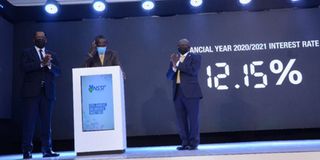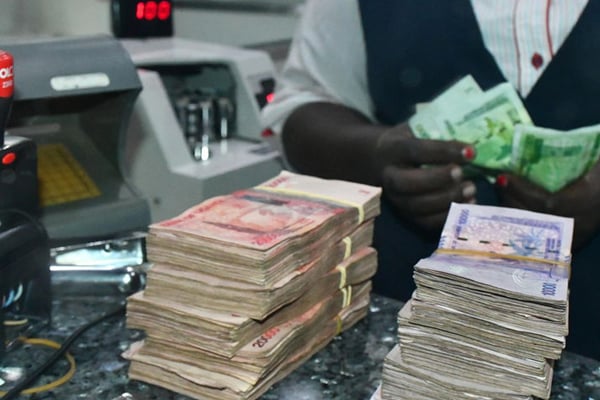NSSF savers set to get lower interest

National Social Security Fund managing director Richard Byarugaba (left) and Finance minister Matia Kasaija (centre) at the NSSF member’s Annual General Meeting last year. PHOTO | FILE
National Social Security Fund (NSSF) members are on course to receive a lower return on their savings than the 12.15 percent interest earned last year when the Fund announces its results in Kampala today, analysts have warned.
A market analyst said the Fund’s interest rate for the year ending June 2022 “would do very well to match last year’s return” at the end of a particularly difficult market environment. “I will be pleasantly surprised if it clears the double-digit mark,” the analyst, who asked not to be identified in order to speak freely, added.
Most of the drag is likely to come from the mid-term payments which started on March 7 and had reached Shs421b by the end of May, the most recent figures publicly available.
This meant that NSSF paid out in three months almost as much money as the Shs450b it paid out in benefits for the whole of the 2018/2019 financial year.
“These pay-outs will have reduced the amount of money available for NSSF to invest,” another market analyst, speaking on condition of anonymity in order not to undermine his relationship with the Fund, told this newspaper.
“It also means that NSSF would have kept this money in cash, or near-cash assets, which earn less interest, while the regulations were finalised.”
Analysts say three other factors could affect NSSF’s financial performance.
The first is the performance of the stock markets, particularly in Kenya, where the Fund owns significant shares on many counters.
In 2020/2021 NSSF’s income grew from Shs1.4 trillion to Shs1.8 trillion buoyed by a 26 percent recovery on the Nairobi Securities Exchange (NSE).
However, the NSE had a bearish run in the first six months of this year, which coincided with the second half of NSSF’s financial year.
The NSE wiped off as much as KShs789 billion in paper wealth as uncertainties about Kenya’s August election, fears of global recession, and a flight to safety and the dollar sucked money out of Kenyan equities market. By the end of June the NSE’s main index was at levels last seen in 2003.
While the market has recovered some of its losses, the bear run will have affected some dividend pay-outs to investors, including NSSF.
The second factor, analysts say, revolves around the exchange rate. Apart from a stronger dollar vacuuming money out of the regional investment markets, the weakening of the Kenyan shilling against the Uganda shilling is likely to reduce NSSF’s takings from that market in dividends.
The Kenyan shilling depreciated against the Ugandan unit from more than 36 in 2020 to 31.5 at the beginning of this year.
Although it has strengthened to between 32-33, the weaker position means that NSSF gets fewer Uganda shillings for each shilling it earned in dividends in Kenya.
The third factor is about how much savers have put into NSSF, even as the Fund was allowing some of them to take out their mid-term payments.
Between June and September 2021, pension contributions by employers to NSSF and other local pension schemes fell from $137 million to $110 million, according to the Uganda Retirement Benefits Regulatory Authority.
This partly reflected the effects of a 42-day lockdown to deal with the second Covid-19 wave in Uganda between June and July 2021.
Although all social and movement restrictions were lifted at the beginning of this year, the long-term effects of job losses, pay cuts and unremitted pension contributions will finally become clear in NSSF’s results today.
Given that NSSF’s returns over the past decade have comfortably beaten inflation and returns from real estate and savings accounts, a sharp dip in interest for the past financial year would ordinarily be seen as a mere bump in the road.
But rising inflation, at home and abroad, makes cash assets less attractive and could convince more savers to take advantage of the mid-term access to hedge against it by moving some of their money into physical assets like land.
This could reduce the investable amount available to NSSF and weigh down returns beyond the current reporting period.
CONCERN FOR HIGH FUNDERS
The bigger worry for analysts, however, are the high net-worth members of the Fund who are relatively few in number but have per capita, a much bigger share of its money. Many are above the age at which they can withdraw all their money from the Fund under its rules.
“As long as NSSF is giving out 13-14 percent per year, it makes sense for these people to keep their money in the Fund and take advantage of the power of compounding,” an investment analyst told this newspaper.
“But if the NSSF interest rate drops sharply and the returns on government paper, for instance, continue to rise, some of them will be taking a long hard look at whether they want to keep their money in NSSF or try to invest it themselves. Now that would cause a bit of a headache for NSSF’s investment analysts and managers.”




